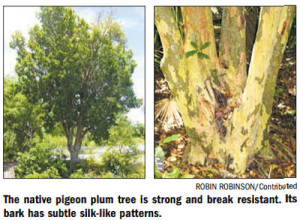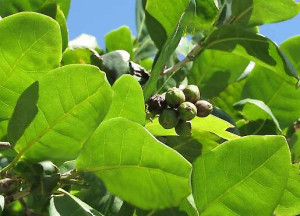The  is a mensch, a real man. He doesn’t show off with flashy flowers or spectacular seeds. He simply does his job in a tropical hardwood hammock with grace and order. He is shaped by a single trunk when young, but soon sprouts new trunks almost parallel to each other. The evergreen leaves of the pigeon plum are sometimes 2 to 4 inches long and other times 4 to 8 inches long. They are thick and generally oval-shaped. They sprout alternately from the branch in a simple pattern. Leaves are attached with an encircling petiole like the sea grape. The shiny, dark-green leaves are densely packed on the tree making a compact canopy up to 50 feet in height and 25 feet in width. Leaves fall in early spring, but red-tinged leaf sprouts, signifying new growth, pop out immediately.
is a mensch, a real man. He doesn’t show off with flashy flowers or spectacular seeds. He simply does his job in a tropical hardwood hammock with grace and order. He is shaped by a single trunk when young, but soon sprouts new trunks almost parallel to each other. The evergreen leaves of the pigeon plum are sometimes 2 to 4 inches long and other times 4 to 8 inches long. They are thick and generally oval-shaped. They sprout alternately from the branch in a simple pattern. Leaves are attached with an encircling petiole like the sea grape. The shiny, dark-green leaves are densely packed on the tree making a compact canopy up to 50 feet in height and 25 feet in width. Leaves fall in early spring, but red-tinged leaf sprouts, signifying new growth, pop out immediately.
The native pigeon plum tree is a close cousin of the sea grape. The trunk of the tree, which resembles the sea grape, often has embedded bark formations. These do not weaken the stalwart tree. When the tree is mature, mottled grey bark peels away to reveal a rust-colored under-bark. Beautiful patterns emerge like those of the silk fabric lining of a man’s suit jacket, not ostentatious, but classy. The native canopy tree is strong and break resistant. It can be planted back from the salt spray but tolerates salty soil as long as it is well drained. This makes it a perfect tree for the alkaline nutrient-poor soil of the Florida Keys. It will thrive in full sun or partial shade.
 The small white flowers grow on 3-inch bracts and turn into a dark-purple fruit beloved by birds. These fruits are edible raw or dried and can be made into jelly or wine. They were an important food of the Miccosukee Indians of South Florida. This gentleman of the hammock is happy to provide superb shelter for birds, food for bees and butterflies, and a scratching post for raccoons. Pigeon plum attracts the rare Schaus swallowtail butterfly and the more common orange sulphur. Warblers, vireo and the threatened white-crowned pigeon feed on its fruit. Inconspicuous, 1/3-inch-long, purple fruit frequently appear mid-summer. The tree continues to flower and fruit year-round. (Although I have spoken about this tree as a gentleman, there are both male and female trees.)
The small white flowers grow on 3-inch bracts and turn into a dark-purple fruit beloved by birds. These fruits are edible raw or dried and can be made into jelly or wine. They were an important food of the Miccosukee Indians of South Florida. This gentleman of the hammock is happy to provide superb shelter for birds, food for bees and butterflies, and a scratching post for raccoons. Pigeon plum attracts the rare Schaus swallowtail butterfly and the more common orange sulphur. Warblers, vireo and the threatened white-crowned pigeon feed on its fruit. Inconspicuous, 1/3-inch-long, purple fruit frequently appear mid-summer. The tree continues to flower and fruit year-round. (Although I have spoken about this tree as a gentleman, there are both male and female trees.)
The handsome pigeon plum can be planted on streets, in parking lots, in native gardens, as a shade tree, on median strips, as buffer plantings or as a specimen tree. It can be planted in a pot on the patio and makes a beautiful shrub. The national champion pigeon plum tree can be found at the back of the pond in the Botanical Gardens on Stock Island. A 10-foot tree can cost up to $200 in local nurseries; however, the Key West Garden Club has propagated this tree from seed and now has 6-foot specimens for sale at under $10. This bargain canopy tree is for sale on Monday mornings or at the upcoming plant sale on Nov. 21-22.
Robin Robinson is author of “Plants of Paradise” and “Roots Rocks and Rain: Native Trees of the Florida Keys.”
